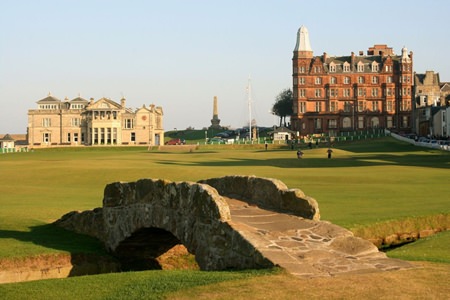This year’s Open Championship, held 16–19 July, will be hosted by the Old Course at St Andrews in Fife, Scotland. It will be the 29th occasion that St Andrews has hosted the Open, now in its 144th year.
The Open Championship is played only on links courses, of which there are ten in the current rota – five in Scotland, four in England and the most recent addition – Royal Portrush in County Antrim, Northern Ireland. Linksland is typically characterized by dunes; an undulating surface and a sandy soil unsuitable for arable farming. Here thrive the indigenous browntop bents and red fescue grasses needed to provide the firm turf associated with links courses and the bump and run game.
 The Swilcan Burn Bridge joining the 1st and 18th fairways on the Old Course at St Andrews.
The Swilcan Burn Bridge joining the 1st and 18th fairways on the Old Course at St Andrews.
The style of play suited to a links course is considerably different from that appropriate to other courses. The challenge of links golf falls mainly into two categories: firstly, the nature of the courses themselves, which tend to be characterised by uneven fairways, thick rough and penal chasms known as “pot bunkers”; and secondly, due to their coastal location and low-lying tree-less terrain; wind.
Two-time Open Champion, Padraig Harrington stated: “It’s startling the way the ball reacts in links golf versus parkland. The ball flies lower. The weather affects the ball so much more. A 10-mph wind on a parkland course is not a big deal, but 10-mph on a links can affect the flight of your ball by 20, 30 yards. The air is heavier. There’s nothing protecting the course from the wind. Everything is magnified.”
The R&A, which determines how the course is set up, has always stated that the winning score in any Open is primarily a product of the weather leading up to and during the event.
And therein lies the biggest factor that will determine how players fare and what score will be posted – the weather. With benign weather, St Andrews is relatively defenceless against today’s pros. The last three Opens held at St Andrews have seen the winner’s score average slightly in excess of 16-under par. Tiger Woods winning score here in 2000 was 19-under par. He repeated five years later by winning his second Open at St Andrews with 14-under par. The last time the Open was held at St Andrews was 2010, when Louis Oosthuizen won with 16-under par.
Some argue that St Andrews is the weakest course on the Open rota. Notwithstanding, no other course, anywhere, has provided such a stage of drama, of memories steeped in the annals of the game. This is after all, the home of golf.
This week, the two men who have won the past three Opens played at St Andrews – Woods and Oosthuizen – will join Jason Day in the opening two rounds. South African Louis Oosthuizen will need to handle the circus that accompanies Tiger Woods whenever he plays golf – something Louis appeared not to do when playing with Tiger in the first round at last month’s US Open. After a first round 77 at Chambers Bay, all seemed lost for Oosthuizen’s chances. He then compiled the lowest final three rounds in US Open history (66-66-67), to finish 4-under and into a tie for second. Louis’s odds are firming, and rightly so, provided he can handle that first round Tiger-hype.
The other player accompanying Tiger in that first round at Chambers Bay was Rickie Fowler. On that day he shot one worse than Tiger – an 81. But last week he won the Scottish Open for his second victory this year. He will be encouraged by what Phil Mickelson did after winning the Scottish Open two years ago. Fowler is another whose odds are firming, and he will enjoy not being part of the “Tiger circus”.
Most talk about favouritism however, is centred on Jordan Spieth. His win at the just completed John Deere Classic in Illinois follows hard on the heels of his US Open victory. Spieth’s Masters win last April, coupled with his US Open win last month, could prove the precursor to a special place in history. If he wins this week, he will join fellow Texan Ben Hogan as the only golfer in history to win the Masters, US Open and Open Championships in the same year. Hogan completed the treble in 1953. The fourth major didn’t exist back then. The PGA Championship was a match play event until 1958. Ben Hogan….what could have been?
Are we about to witness a Hogan-like performance from another golfer from Texas?
One player who must feel the Open “owes” him is Adam Scott. His “melt-down” that handed Ernie Ells an unexpected one-stroke victory in 2012, must still rankle. Scott has found some form following the return of bagman, Steve Williams, who has come out of retirement to be with his fellow Anzac.
The last of five “horses” mentioned here is the highly-fancied Justin Rose. He finished tied for second at this year’s Masters, and tied 27th in June’s US Open. His last win on tour was at this year’s Zurich Classic at New Orleans, in April. He won last year’s Scottish Open.
The odds on these five featured players, curtesy of Paddy Power as at Tuesday 14 July, are:
- Joran Spieth: 6/1
- Rickie Fowler: 16/1
- Justin Rose: 18/1
- Adam Scott: 20/1
- Louis Oosthuizen: 22/1
Lastly, a couple of less-fancied golfers, but whose odds I find attractive:
- Shane Lowry 33/1
- Rafael Cabrera Bello 125/1
By the time this is published, the first round will have been completed. Enjoy.
Golfnutter




